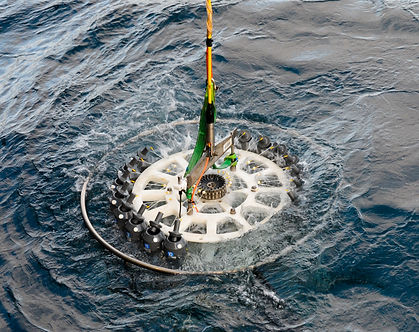
Entry 02
February 13 2025
CTD, fish and a vast array of data


Our supply containers have been delayed so, while we wait, let me tell you about the different experiments we have planned, and what sort of data we hope to get from them. There are two main types of experiments that correlate with sampling methods; those from the CTD, and those from the Tow-Fish. The CTD, a large Rosette device, has 24 sampling bottles and can go down to a depth of 6km before ascending and collecting samples from different depths. The CTD also measures the physical parameters in terms of water conductivity, temperature and depth (from where it gets its name). The Tow-Fish is a much smaller deployment that is suspended over the side of the ship and pumps water from the surface straight into our metal-free container. The Fish collects water from a distance away from the ship so as not to be contaminated by the ship itself. The samples it collects are trace-metal free and so when looking at things like Iron (a trace metal in seawater) there is no interference from the ship environment.
The CTD we'll allows us to look at depth. An important concept in this research is the Deep Chlorophyll Maxima, essentially a region around 100m below the surface of the ocean where light is so low (around 1% of surface irradiance) that the phytoplankton community there massively upregulates the concentration of chlorophyll (the green pigment in plants and algae) to allow them to continue to photosynthesise. We are interested in understanding what that community is and what is going on on a genetic level to observe what genes are switched on or off under what conditions.


The samples collected by the Tow-Fish will enable us to look at nutrient limitation. By adding macro- and micro-nutrients to the natural community and incubating them for a period of time we can observe the community response in terms of how the community changes, and what type of genetic responses individual phytoplankton have.
In addition to the genetic analysis, we'll be measuring and sampling for many other things: chlorophyll, size-fractionated chlorophyll, scanning electron microscopy, flow cytometry, flow-cam, and more. This will combine to provide a more complete dataset to help understand the current status of the ocean. Shift patterns will not be set but generally samples need to be taken before the sunrises at dawn. This means that most days will begin at 0300 hours.
